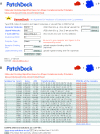PatchDock and SymmDock: servers for rigid and symmetric docking
- PMID: 15980490
- PMCID: PMC1160241
- DOI: 10.1093/nar/gki481
PatchDock and SymmDock: servers for rigid and symmetric docking
Abstract
Here, we describe two freely available web servers for molecular docking. The PatchDock method performs structure prediction of protein-protein and protein-small molecule complexes. The SymmDock method predicts the structure of a homomultimer with cyclic symmetry given the structure of the monomeric unit. The inputs to the servers are either protein PDB codes or uploaded protein structures. The services are available at http://bioinfo3d.cs.tau.ac.il. The methods behind the servers are very efficient, allowing large-scale docking experiments.
Figures


References
-
- Kuntz I., Blaney J., Oatley S., Langridge R., Ferrin T. A geometric approach to macromolecule–ligand interactions. J. Mol. Biol. 1982;161:269–288. - PubMed
-
- Connolly M.L. Shape complementarity at the hemoglobin alpha 1 beta 1 subunit interface. Biopolymers. 1986;25:1229–1247. - PubMed
-
- Jiang F., Kim S. “Soft docking”: matching of molecular surface cubes. J. Mol. Biol. 1991;219:79–102. - PubMed
-
- Walls P., Sternberg M. New algorithms to model protein–protein recognition based on surface complementarity; applications to antibody–antigen docking. J. Mol. Biol. 1992;228:227–297. - PubMed
Publication types
MeSH terms
Substances
Grants and funding
LinkOut - more resources
Full Text Sources
Other Literature Sources

